Determining Tax Residency Status and Taxation of Income
VerifiedAdded on 2023/01/17
|12
|3024
|21
AI Summary
This article provides a comprehensive guide on determining tax residency status and understanding the taxation of income. It covers the different tests used to determine residency, such as the ordinary concepts test, domicile test, 183 days test, and superannuation test. It also explains the taxation of income for non-residents and provides insights on how to handle specific scenarios. Whether you're a student studying taxation law or an individual looking for expert advice, this guide is a valuable resource.
Contribute Materials
Your contribution can guide someone’s learning journey. Share your
documents today.
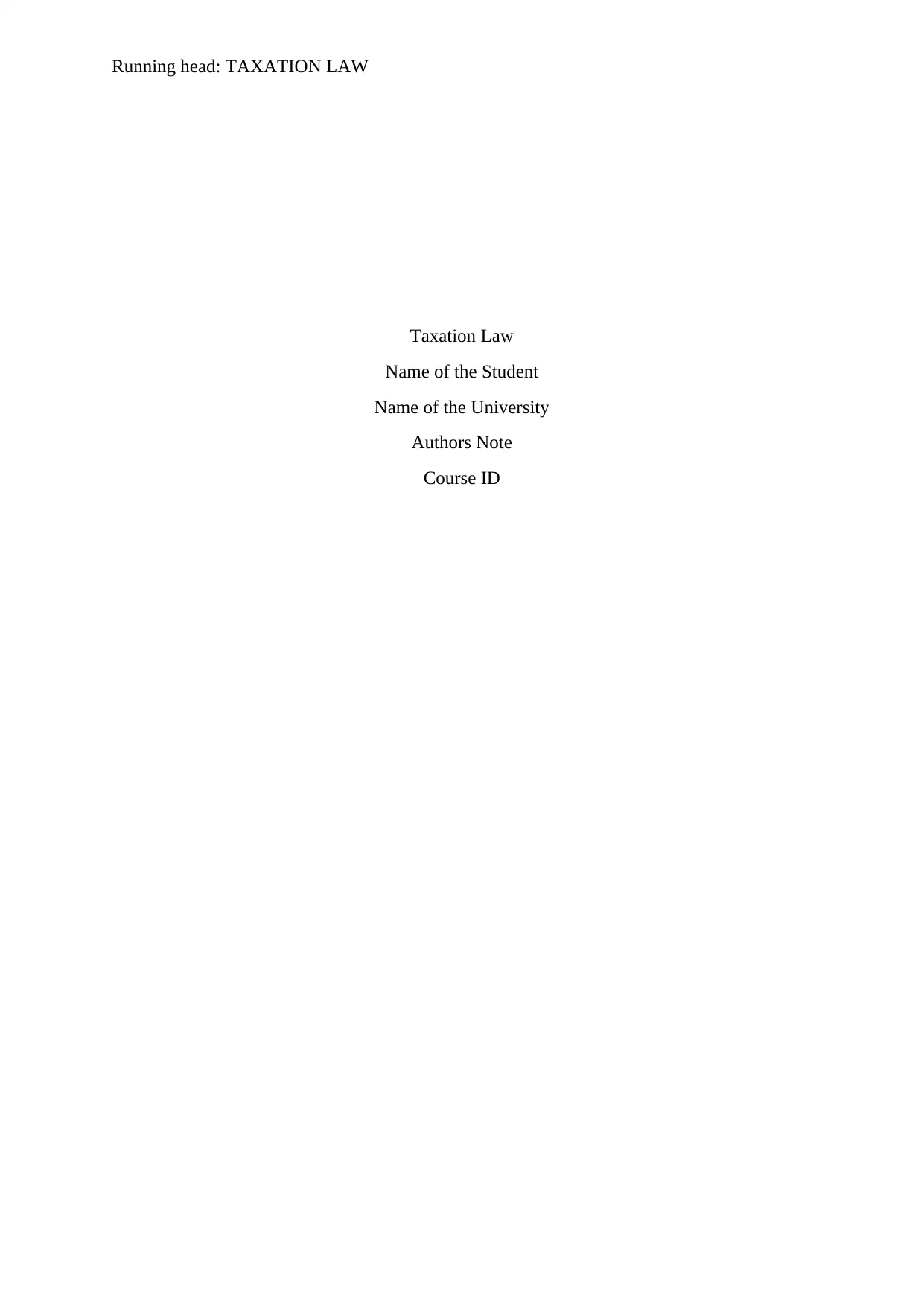
Running head: TAXATION LAW
Taxation Law
Name of the Student
Name of the University
Authors Note
Course ID
Taxation Law
Name of the Student
Name of the University
Authors Note
Course ID
Secure Best Marks with AI Grader
Need help grading? Try our AI Grader for instant feedback on your assignments.
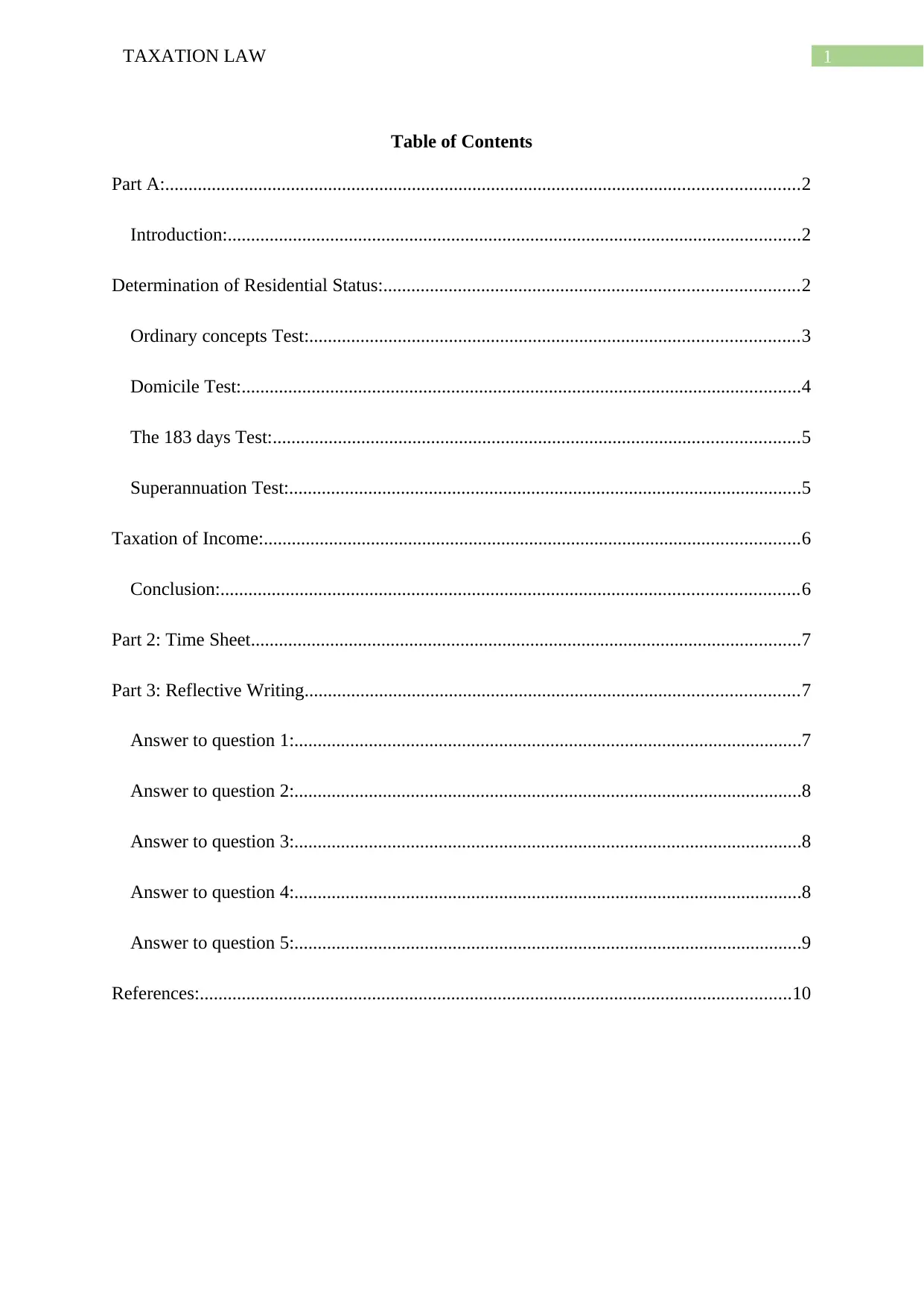
1TAXATION LAW
Table of Contents
Part A:........................................................................................................................................2
Introduction:...........................................................................................................................2
Determination of Residential Status:.........................................................................................2
Ordinary concepts Test:.........................................................................................................3
Domicile Test:........................................................................................................................4
The 183 days Test:.................................................................................................................5
Superannuation Test:..............................................................................................................5
Taxation of Income:...................................................................................................................6
Conclusion:............................................................................................................................6
Part 2: Time Sheet......................................................................................................................7
Part 3: Reflective Writing..........................................................................................................7
Answer to question 1:.............................................................................................................7
Answer to question 2:.............................................................................................................8
Answer to question 3:.............................................................................................................8
Answer to question 4:.............................................................................................................8
Answer to question 5:.............................................................................................................9
References:...............................................................................................................................10
Table of Contents
Part A:........................................................................................................................................2
Introduction:...........................................................................................................................2
Determination of Residential Status:.........................................................................................2
Ordinary concepts Test:.........................................................................................................3
Domicile Test:........................................................................................................................4
The 183 days Test:.................................................................................................................5
Superannuation Test:..............................................................................................................5
Taxation of Income:...................................................................................................................6
Conclusion:............................................................................................................................6
Part 2: Time Sheet......................................................................................................................7
Part 3: Reflective Writing..........................................................................................................7
Answer to question 1:.............................................................................................................7
Answer to question 2:.............................................................................................................8
Answer to question 3:.............................................................................................................8
Answer to question 4:.............................................................................................................8
Answer to question 5:.............................................................................................................9
References:...............................................................................................................................10
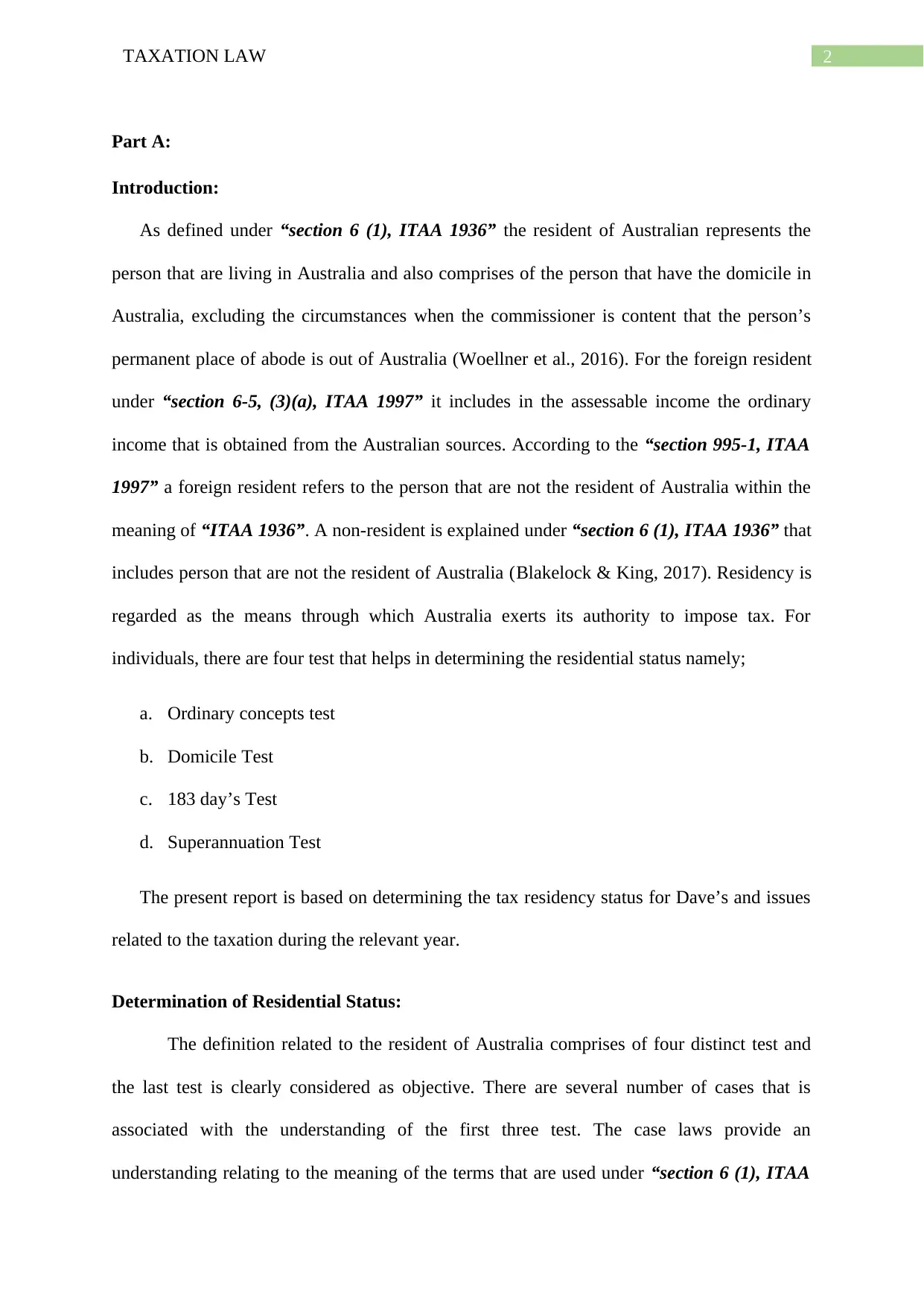
2TAXATION LAW
Part A:
Introduction:
As defined under “section 6 (1), ITAA 1936” the resident of Australian represents the
person that are living in Australia and also comprises of the person that have the domicile in
Australia, excluding the circumstances when the commissioner is content that the person’s
permanent place of abode is out of Australia (Woellner et al., 2016). For the foreign resident
under “section 6-5, (3)(a), ITAA 1997” it includes in the assessable income the ordinary
income that is obtained from the Australian sources. According to the “section 995-1, ITAA
1997” a foreign resident refers to the person that are not the resident of Australia within the
meaning of “ITAA 1936”. A non-resident is explained under “section 6 (1), ITAA 1936” that
includes person that are not the resident of Australia (Blakelock & King, 2017). Residency is
regarded as the means through which Australia exerts its authority to impose tax. For
individuals, there are four test that helps in determining the residential status namely;
a. Ordinary concepts test
b. Domicile Test
c. 183 day’s Test
d. Superannuation Test
The present report is based on determining the tax residency status for Dave’s and issues
related to the taxation during the relevant year.
Determination of Residential Status:
The definition related to the resident of Australia comprises of four distinct test and
the last test is clearly considered as objective. There are several number of cases that is
associated with the understanding of the first three test. The case laws provide an
understanding relating to the meaning of the terms that are used under “section 6 (1), ITAA
Part A:
Introduction:
As defined under “section 6 (1), ITAA 1936” the resident of Australian represents the
person that are living in Australia and also comprises of the person that have the domicile in
Australia, excluding the circumstances when the commissioner is content that the person’s
permanent place of abode is out of Australia (Woellner et al., 2016). For the foreign resident
under “section 6-5, (3)(a), ITAA 1997” it includes in the assessable income the ordinary
income that is obtained from the Australian sources. According to the “section 995-1, ITAA
1997” a foreign resident refers to the person that are not the resident of Australia within the
meaning of “ITAA 1936”. A non-resident is explained under “section 6 (1), ITAA 1936” that
includes person that are not the resident of Australia (Blakelock & King, 2017). Residency is
regarded as the means through which Australia exerts its authority to impose tax. For
individuals, there are four test that helps in determining the residential status namely;
a. Ordinary concepts test
b. Domicile Test
c. 183 day’s Test
d. Superannuation Test
The present report is based on determining the tax residency status for Dave’s and issues
related to the taxation during the relevant year.
Determination of Residential Status:
The definition related to the resident of Australia comprises of four distinct test and
the last test is clearly considered as objective. There are several number of cases that is
associated with the understanding of the first three test. The case laws provide an
understanding relating to the meaning of the terms that are used under “section 6 (1), ITAA
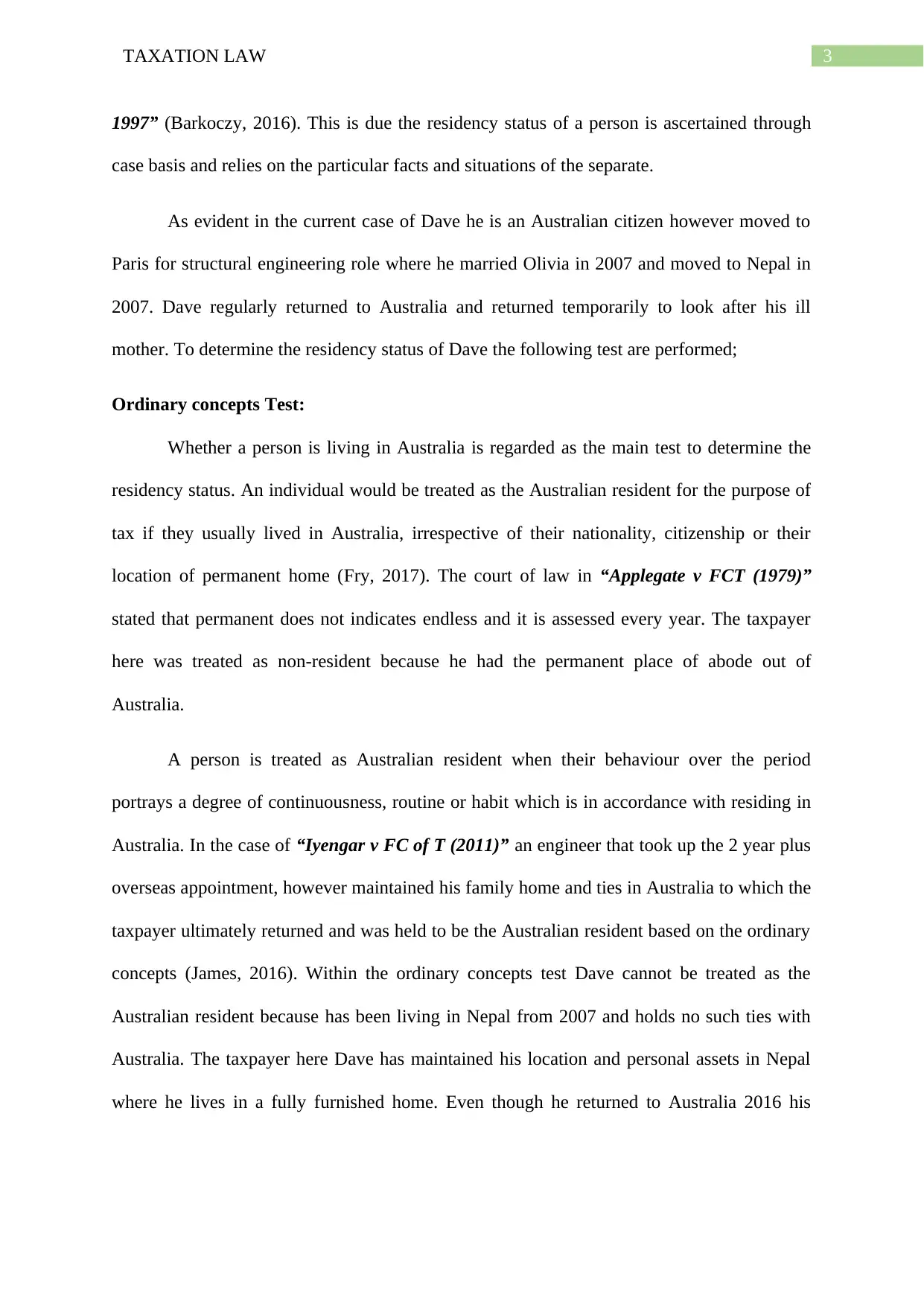
3TAXATION LAW
1997” (Barkoczy, 2016). This is due the residency status of a person is ascertained through
case basis and relies on the particular facts and situations of the separate.
As evident in the current case of Dave he is an Australian citizen however moved to
Paris for structural engineering role where he married Olivia in 2007 and moved to Nepal in
2007. Dave regularly returned to Australia and returned temporarily to look after his ill
mother. To determine the residency status of Dave the following test are performed;
Ordinary concepts Test:
Whether a person is living in Australia is regarded as the main test to determine the
residency status. An individual would be treated as the Australian resident for the purpose of
tax if they usually lived in Australia, irrespective of their nationality, citizenship or their
location of permanent home (Fry, 2017). The court of law in “Applegate v FCT (1979)”
stated that permanent does not indicates endless and it is assessed every year. The taxpayer
here was treated as non-resident because he had the permanent place of abode out of
Australia.
A person is treated as Australian resident when their behaviour over the period
portrays a degree of continuousness, routine or habit which is in accordance with residing in
Australia. In the case of “Iyengar v FC of T (2011)” an engineer that took up the 2 year plus
overseas appointment, however maintained his family home and ties in Australia to which the
taxpayer ultimately returned and was held to be the Australian resident based on the ordinary
concepts (James, 2016). Within the ordinary concepts test Dave cannot be treated as the
Australian resident because has been living in Nepal from 2007 and holds no such ties with
Australia. The taxpayer here Dave has maintained his location and personal assets in Nepal
where he lives in a fully furnished home. Even though he returned to Australia 2016 his
1997” (Barkoczy, 2016). This is due the residency status of a person is ascertained through
case basis and relies on the particular facts and situations of the separate.
As evident in the current case of Dave he is an Australian citizen however moved to
Paris for structural engineering role where he married Olivia in 2007 and moved to Nepal in
2007. Dave regularly returned to Australia and returned temporarily to look after his ill
mother. To determine the residency status of Dave the following test are performed;
Ordinary concepts Test:
Whether a person is living in Australia is regarded as the main test to determine the
residency status. An individual would be treated as the Australian resident for the purpose of
tax if they usually lived in Australia, irrespective of their nationality, citizenship or their
location of permanent home (Fry, 2017). The court of law in “Applegate v FCT (1979)”
stated that permanent does not indicates endless and it is assessed every year. The taxpayer
here was treated as non-resident because he had the permanent place of abode out of
Australia.
A person is treated as Australian resident when their behaviour over the period
portrays a degree of continuousness, routine or habit which is in accordance with residing in
Australia. In the case of “Iyengar v FC of T (2011)” an engineer that took up the 2 year plus
overseas appointment, however maintained his family home and ties in Australia to which the
taxpayer ultimately returned and was held to be the Australian resident based on the ordinary
concepts (James, 2016). Within the ordinary concepts test Dave cannot be treated as the
Australian resident because has been living in Nepal from 2007 and holds no such ties with
Australia. The taxpayer here Dave has maintained his location and personal assets in Nepal
where he lives in a fully furnished home. Even though he returned to Australia 2016 his
Secure Best Marks with AI Grader
Need help grading? Try our AI Grader for instant feedback on your assignments.
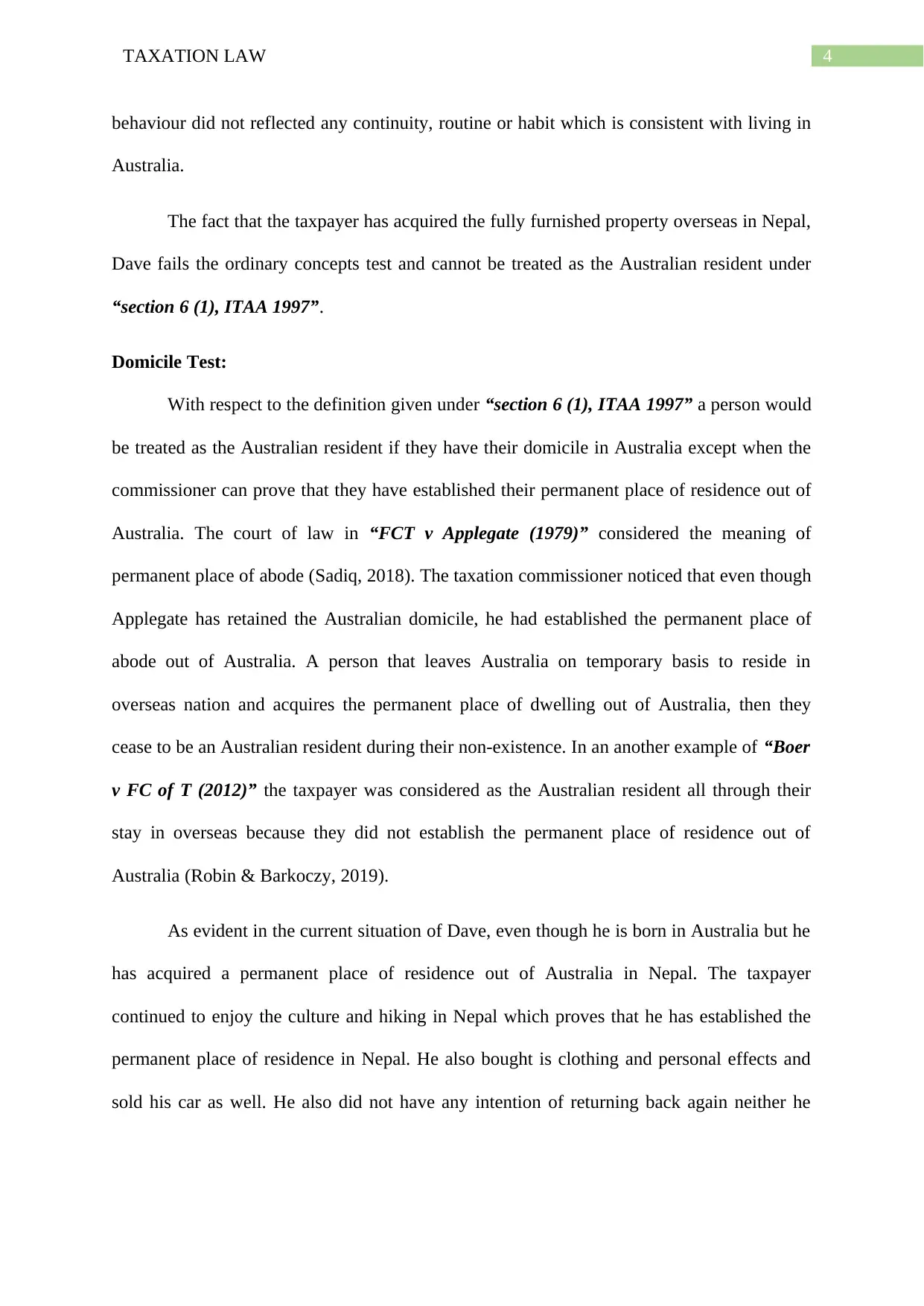
4TAXATION LAW
behaviour did not reflected any continuity, routine or habit which is consistent with living in
Australia.
The fact that the taxpayer has acquired the fully furnished property overseas in Nepal,
Dave fails the ordinary concepts test and cannot be treated as the Australian resident under
“section 6 (1), ITAA 1997”.
Domicile Test:
With respect to the definition given under “section 6 (1), ITAA 1997” a person would
be treated as the Australian resident if they have their domicile in Australia except when the
commissioner can prove that they have established their permanent place of residence out of
Australia. The court of law in “FCT v Applegate (1979)” considered the meaning of
permanent place of abode (Sadiq, 2018). The taxation commissioner noticed that even though
Applegate has retained the Australian domicile, he had established the permanent place of
abode out of Australia. A person that leaves Australia on temporary basis to reside in
overseas nation and acquires the permanent place of dwelling out of Australia, then they
cease to be an Australian resident during their non-existence. In an another example of “Boer
v FC of T (2012)” the taxpayer was considered as the Australian resident all through their
stay in overseas because they did not establish the permanent place of residence out of
Australia (Robin & Barkoczy, 2019).
As evident in the current situation of Dave, even though he is born in Australia but he
has acquired a permanent place of residence out of Australia in Nepal. The taxpayer
continued to enjoy the culture and hiking in Nepal which proves that he has established the
permanent place of residence in Nepal. He also bought is clothing and personal effects and
sold his car as well. He also did not have any intention of returning back again neither he
behaviour did not reflected any continuity, routine or habit which is consistent with living in
Australia.
The fact that the taxpayer has acquired the fully furnished property overseas in Nepal,
Dave fails the ordinary concepts test and cannot be treated as the Australian resident under
“section 6 (1), ITAA 1997”.
Domicile Test:
With respect to the definition given under “section 6 (1), ITAA 1997” a person would
be treated as the Australian resident if they have their domicile in Australia except when the
commissioner can prove that they have established their permanent place of residence out of
Australia. The court of law in “FCT v Applegate (1979)” considered the meaning of
permanent place of abode (Sadiq, 2018). The taxation commissioner noticed that even though
Applegate has retained the Australian domicile, he had established the permanent place of
abode out of Australia. A person that leaves Australia on temporary basis to reside in
overseas nation and acquires the permanent place of dwelling out of Australia, then they
cease to be an Australian resident during their non-existence. In an another example of “Boer
v FC of T (2012)” the taxpayer was considered as the Australian resident all through their
stay in overseas because they did not establish the permanent place of residence out of
Australia (Robin & Barkoczy, 2019).
As evident in the current situation of Dave, even though he is born in Australia but he
has acquired a permanent place of residence out of Australia in Nepal. The taxpayer
continued to enjoy the culture and hiking in Nepal which proves that he has established the
permanent place of residence in Nepal. He also bought is clothing and personal effects and
sold his car as well. He also did not have any intention of returning back again neither he
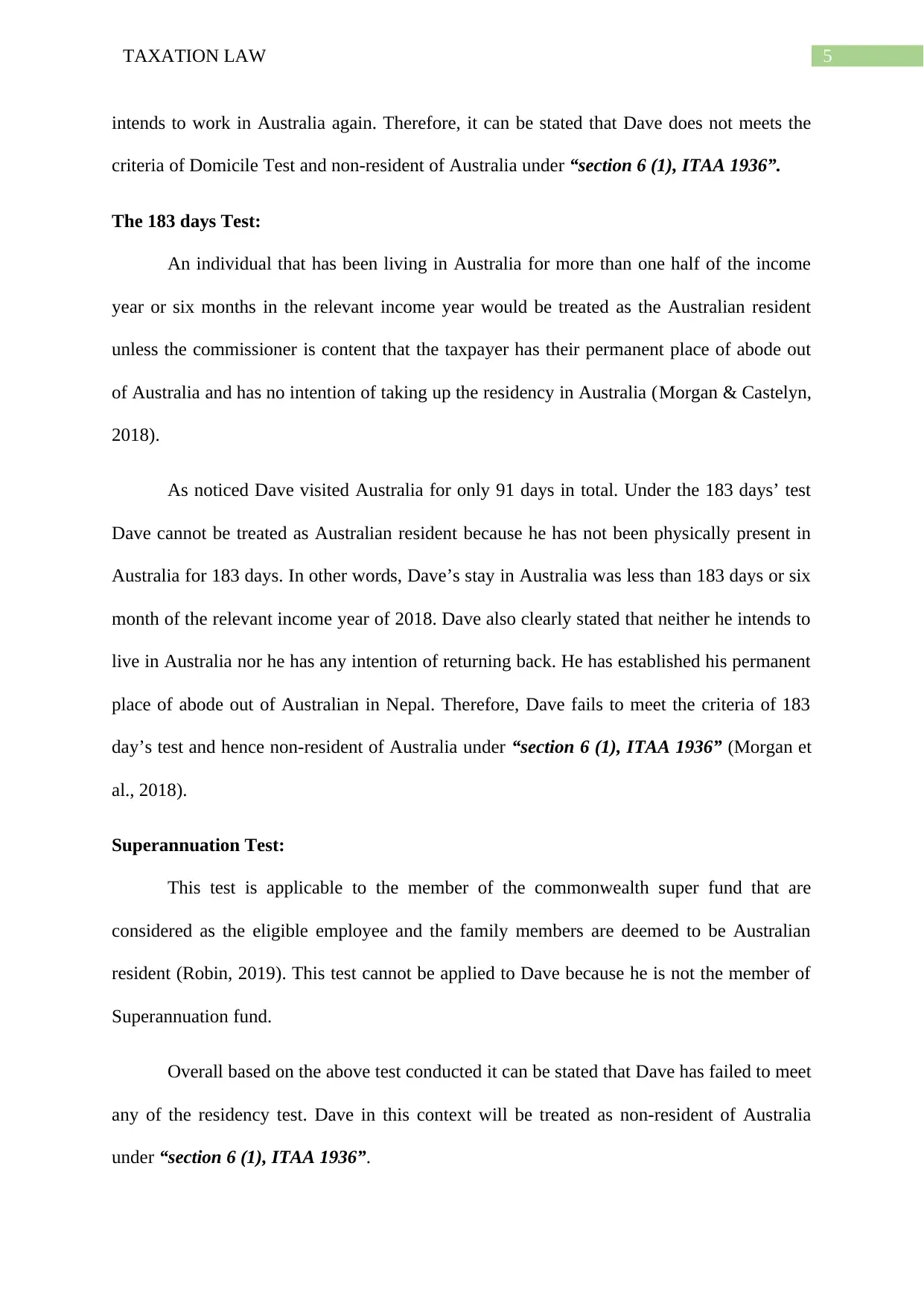
5TAXATION LAW
intends to work in Australia again. Therefore, it can be stated that Dave does not meets the
criteria of Domicile Test and non-resident of Australia under “section 6 (1), ITAA 1936”.
The 183 days Test:
An individual that has been living in Australia for more than one half of the income
year or six months in the relevant income year would be treated as the Australian resident
unless the commissioner is content that the taxpayer has their permanent place of abode out
of Australia and has no intention of taking up the residency in Australia (Morgan & Castelyn,
2018).
As noticed Dave visited Australia for only 91 days in total. Under the 183 days’ test
Dave cannot be treated as Australian resident because he has not been physically present in
Australia for 183 days. In other words, Dave’s stay in Australia was less than 183 days or six
month of the relevant income year of 2018. Dave also clearly stated that neither he intends to
live in Australia nor he has any intention of returning back. He has established his permanent
place of abode out of Australian in Nepal. Therefore, Dave fails to meet the criteria of 183
day’s test and hence non-resident of Australia under “section 6 (1), ITAA 1936” (Morgan et
al., 2018).
Superannuation Test:
This test is applicable to the member of the commonwealth super fund that are
considered as the eligible employee and the family members are deemed to be Australian
resident (Robin, 2019). This test cannot be applied to Dave because he is not the member of
Superannuation fund.
Overall based on the above test conducted it can be stated that Dave has failed to meet
any of the residency test. Dave in this context will be treated as non-resident of Australia
under “section 6 (1), ITAA 1936”.
intends to work in Australia again. Therefore, it can be stated that Dave does not meets the
criteria of Domicile Test and non-resident of Australia under “section 6 (1), ITAA 1936”.
The 183 days Test:
An individual that has been living in Australia for more than one half of the income
year or six months in the relevant income year would be treated as the Australian resident
unless the commissioner is content that the taxpayer has their permanent place of abode out
of Australia and has no intention of taking up the residency in Australia (Morgan & Castelyn,
2018).
As noticed Dave visited Australia for only 91 days in total. Under the 183 days’ test
Dave cannot be treated as Australian resident because he has not been physically present in
Australia for 183 days. In other words, Dave’s stay in Australia was less than 183 days or six
month of the relevant income year of 2018. Dave also clearly stated that neither he intends to
live in Australia nor he has any intention of returning back. He has established his permanent
place of abode out of Australian in Nepal. Therefore, Dave fails to meet the criteria of 183
day’s test and hence non-resident of Australia under “section 6 (1), ITAA 1936” (Morgan et
al., 2018).
Superannuation Test:
This test is applicable to the member of the commonwealth super fund that are
considered as the eligible employee and the family members are deemed to be Australian
resident (Robin, 2019). This test cannot be applied to Dave because he is not the member of
Superannuation fund.
Overall based on the above test conducted it can be stated that Dave has failed to meet
any of the residency test. Dave in this context will be treated as non-resident of Australia
under “section 6 (1), ITAA 1936”.
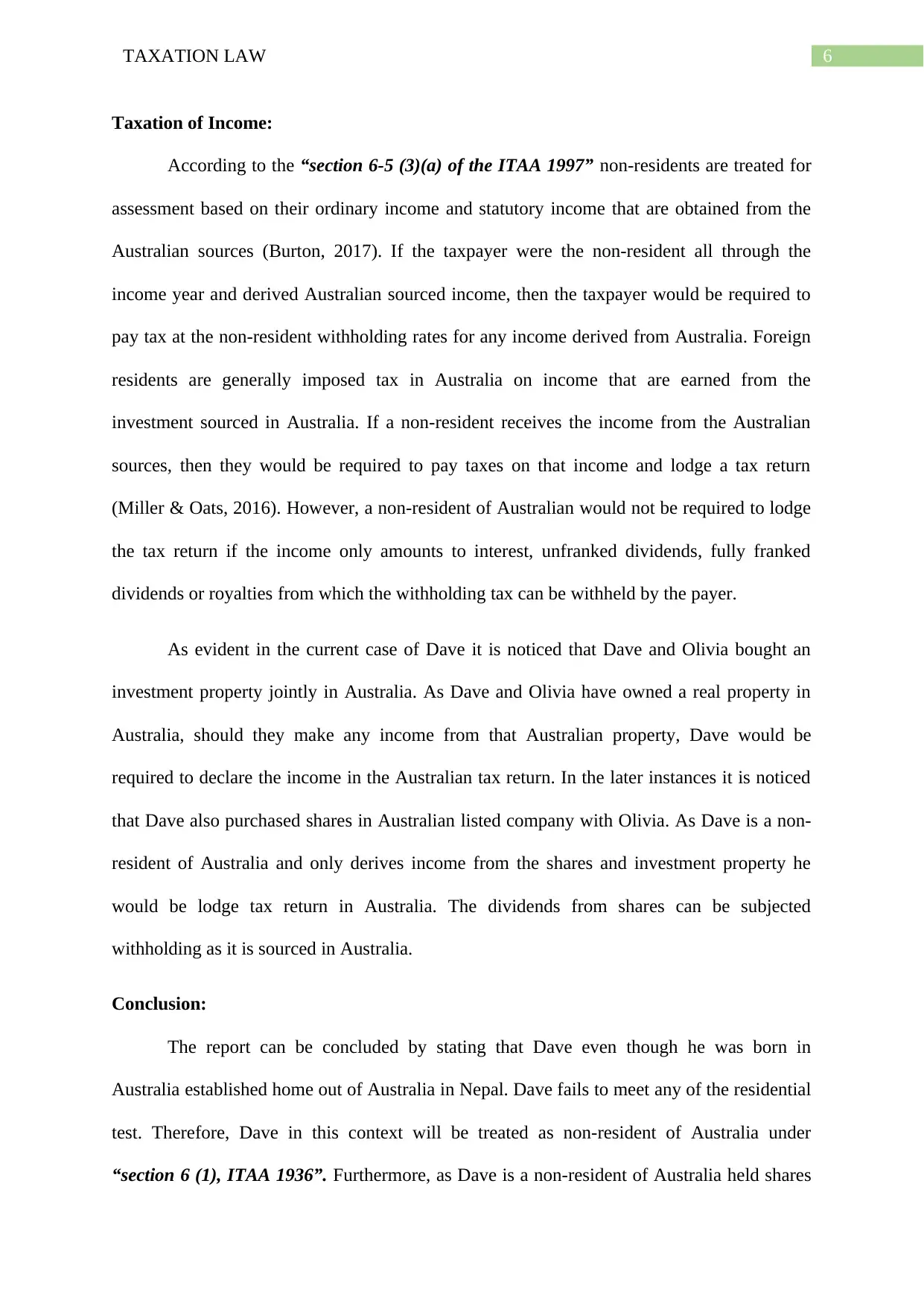
6TAXATION LAW
Taxation of Income:
According to the “section 6-5 (3)(a) of the ITAA 1997” non-residents are treated for
assessment based on their ordinary income and statutory income that are obtained from the
Australian sources (Burton, 2017). If the taxpayer were the non-resident all through the
income year and derived Australian sourced income, then the taxpayer would be required to
pay tax at the non-resident withholding rates for any income derived from Australia. Foreign
residents are generally imposed tax in Australia on income that are earned from the
investment sourced in Australia. If a non-resident receives the income from the Australian
sources, then they would be required to pay taxes on that income and lodge a tax return
(Miller & Oats, 2016). However, a non-resident of Australian would not be required to lodge
the tax return if the income only amounts to interest, unfranked dividends, fully franked
dividends or royalties from which the withholding tax can be withheld by the payer.
As evident in the current case of Dave it is noticed that Dave and Olivia bought an
investment property jointly in Australia. As Dave and Olivia have owned a real property in
Australia, should they make any income from that Australian property, Dave would be
required to declare the income in the Australian tax return. In the later instances it is noticed
that Dave also purchased shares in Australian listed company with Olivia. As Dave is a non-
resident of Australia and only derives income from the shares and investment property he
would be lodge tax return in Australia. The dividends from shares can be subjected
withholding as it is sourced in Australia.
Conclusion:
The report can be concluded by stating that Dave even though he was born in
Australia established home out of Australia in Nepal. Dave fails to meet any of the residential
test. Therefore, Dave in this context will be treated as non-resident of Australia under
“section 6 (1), ITAA 1936”. Furthermore, as Dave is a non-resident of Australia held shares
Taxation of Income:
According to the “section 6-5 (3)(a) of the ITAA 1997” non-residents are treated for
assessment based on their ordinary income and statutory income that are obtained from the
Australian sources (Burton, 2017). If the taxpayer were the non-resident all through the
income year and derived Australian sourced income, then the taxpayer would be required to
pay tax at the non-resident withholding rates for any income derived from Australia. Foreign
residents are generally imposed tax in Australia on income that are earned from the
investment sourced in Australia. If a non-resident receives the income from the Australian
sources, then they would be required to pay taxes on that income and lodge a tax return
(Miller & Oats, 2016). However, a non-resident of Australian would not be required to lodge
the tax return if the income only amounts to interest, unfranked dividends, fully franked
dividends or royalties from which the withholding tax can be withheld by the payer.
As evident in the current case of Dave it is noticed that Dave and Olivia bought an
investment property jointly in Australia. As Dave and Olivia have owned a real property in
Australia, should they make any income from that Australian property, Dave would be
required to declare the income in the Australian tax return. In the later instances it is noticed
that Dave also purchased shares in Australian listed company with Olivia. As Dave is a non-
resident of Australia and only derives income from the shares and investment property he
would be lodge tax return in Australia. The dividends from shares can be subjected
withholding as it is sourced in Australia.
Conclusion:
The report can be concluded by stating that Dave even though he was born in
Australia established home out of Australia in Nepal. Dave fails to meet any of the residential
test. Therefore, Dave in this context will be treated as non-resident of Australia under
“section 6 (1), ITAA 1936”. Furthermore, as Dave is a non-resident of Australia held shares
Paraphrase This Document
Need a fresh take? Get an instant paraphrase of this document with our AI Paraphraser
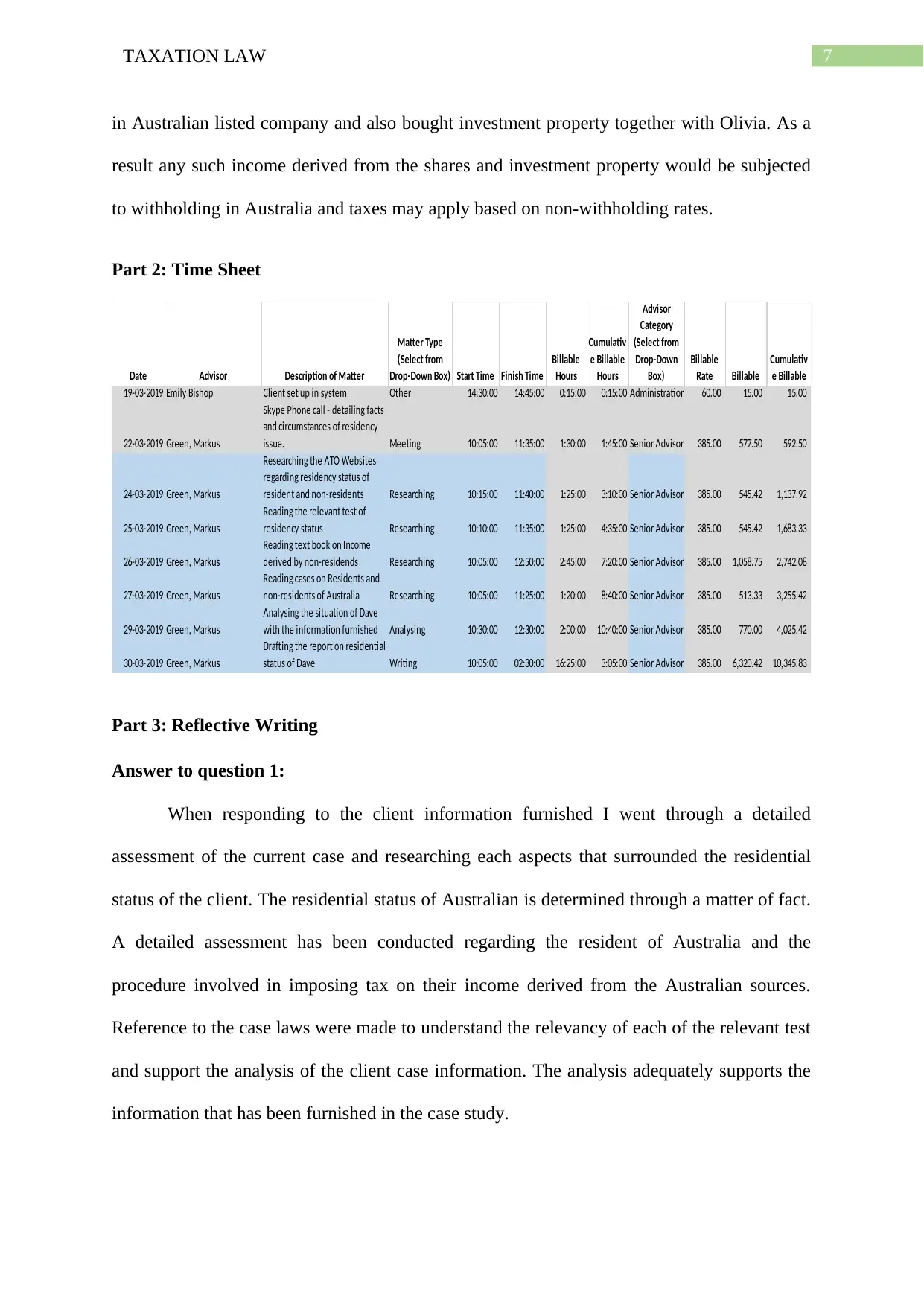
7TAXATION LAW
in Australian listed company and also bought investment property together with Olivia. As a
result any such income derived from the shares and investment property would be subjected
to withholding in Australia and taxes may apply based on non-withholding rates.
Part 2: Time Sheet
Date Advisor Description of Matter
Matter Type
(Select from
Drop-Down Box) Start Time Finish Time
Billable
Hours
Cumulativ
e Billable
Hours
Advisor
Category
(Select from
Drop-Down
Box)
Billable
Rate Billable
Cumulativ
e Billable
19-03-2019 Emily Bishop Client set up in system Other 14:30:00 14:45:00 0:15:00 0:15:00 Administration 60.00 15.00 15.00
22-03-2019 Green, Markus
Skype Phone call - detailing facts
and circumstances of residency
issue. Meeting 10:05:00 11:35:00 1:30:00 1:45:00 Senior Advisor 385.00 577.50 592.50
24-03-2019 Green, Markus
Researching the ATO Websites
regarding residency status of
resident and non-residents Researching 10:15:00 11:40:00 1:25:00 3:10:00 Senior Advisor 385.00 545.42 1,137.92
25-03-2019 Green, Markus
Reading the relevant test of
residency status Researching 10:10:00 11:35:00 1:25:00 4:35:00 Senior Advisor 385.00 545.42 1,683.33
26-03-2019 Green, Markus
Reading text book on Income
derived by non-residends Researching 10:05:00 12:50:00 2:45:00 7:20:00 Senior Advisor 385.00 1,058.75 2,742.08
27-03-2019 Green, Markus
Reading cases on Residents and
non-residents of Australia Researching 10:05:00 11:25:00 1:20:00 8:40:00 Senior Advisor 385.00 513.33 3,255.42
29-03-2019 Green, Markus
Analysing the situation of Dave
with the information furnished Analysing 10:30:00 12:30:00 2:00:00 10:40:00 Senior Advisor 385.00 770.00 4,025.42
30-03-2019 Green, Markus
Drafting the report on residential
status of Dave Writing 10:05:00 02:30:00 16:25:00 3:05:00 Senior Advisor 385.00 6,320.42 10,345.83
Part 3: Reflective Writing
Answer to question 1:
When responding to the client information furnished I went through a detailed
assessment of the current case and researching each aspects that surrounded the residential
status of the client. The residential status of Australian is determined through a matter of fact.
A detailed assessment has been conducted regarding the resident of Australia and the
procedure involved in imposing tax on their income derived from the Australian sources.
Reference to the case laws were made to understand the relevancy of each of the relevant test
and support the analysis of the client case information. The analysis adequately supports the
information that has been furnished in the case study.
in Australian listed company and also bought investment property together with Olivia. As a
result any such income derived from the shares and investment property would be subjected
to withholding in Australia and taxes may apply based on non-withholding rates.
Part 2: Time Sheet
Date Advisor Description of Matter
Matter Type
(Select from
Drop-Down Box) Start Time Finish Time
Billable
Hours
Cumulativ
e Billable
Hours
Advisor
Category
(Select from
Drop-Down
Box)
Billable
Rate Billable
Cumulativ
e Billable
19-03-2019 Emily Bishop Client set up in system Other 14:30:00 14:45:00 0:15:00 0:15:00 Administration 60.00 15.00 15.00
22-03-2019 Green, Markus
Skype Phone call - detailing facts
and circumstances of residency
issue. Meeting 10:05:00 11:35:00 1:30:00 1:45:00 Senior Advisor 385.00 577.50 592.50
24-03-2019 Green, Markus
Researching the ATO Websites
regarding residency status of
resident and non-residents Researching 10:15:00 11:40:00 1:25:00 3:10:00 Senior Advisor 385.00 545.42 1,137.92
25-03-2019 Green, Markus
Reading the relevant test of
residency status Researching 10:10:00 11:35:00 1:25:00 4:35:00 Senior Advisor 385.00 545.42 1,683.33
26-03-2019 Green, Markus
Reading text book on Income
derived by non-residends Researching 10:05:00 12:50:00 2:45:00 7:20:00 Senior Advisor 385.00 1,058.75 2,742.08
27-03-2019 Green, Markus
Reading cases on Residents and
non-residents of Australia Researching 10:05:00 11:25:00 1:20:00 8:40:00 Senior Advisor 385.00 513.33 3,255.42
29-03-2019 Green, Markus
Analysing the situation of Dave
with the information furnished Analysing 10:30:00 12:30:00 2:00:00 10:40:00 Senior Advisor 385.00 770.00 4,025.42
30-03-2019 Green, Markus
Drafting the report on residential
status of Dave Writing 10:05:00 02:30:00 16:25:00 3:05:00 Senior Advisor 385.00 6,320.42 10,345.83
Part 3: Reflective Writing
Answer to question 1:
When responding to the client information furnished I went through a detailed
assessment of the current case and researching each aspects that surrounded the residential
status of the client. The residential status of Australian is determined through a matter of fact.
A detailed assessment has been conducted regarding the resident of Australia and the
procedure involved in imposing tax on their income derived from the Australian sources.
Reference to the case laws were made to understand the relevancy of each of the relevant test
and support the analysis of the client case information. The analysis adequately supports the
information that has been furnished in the case study.
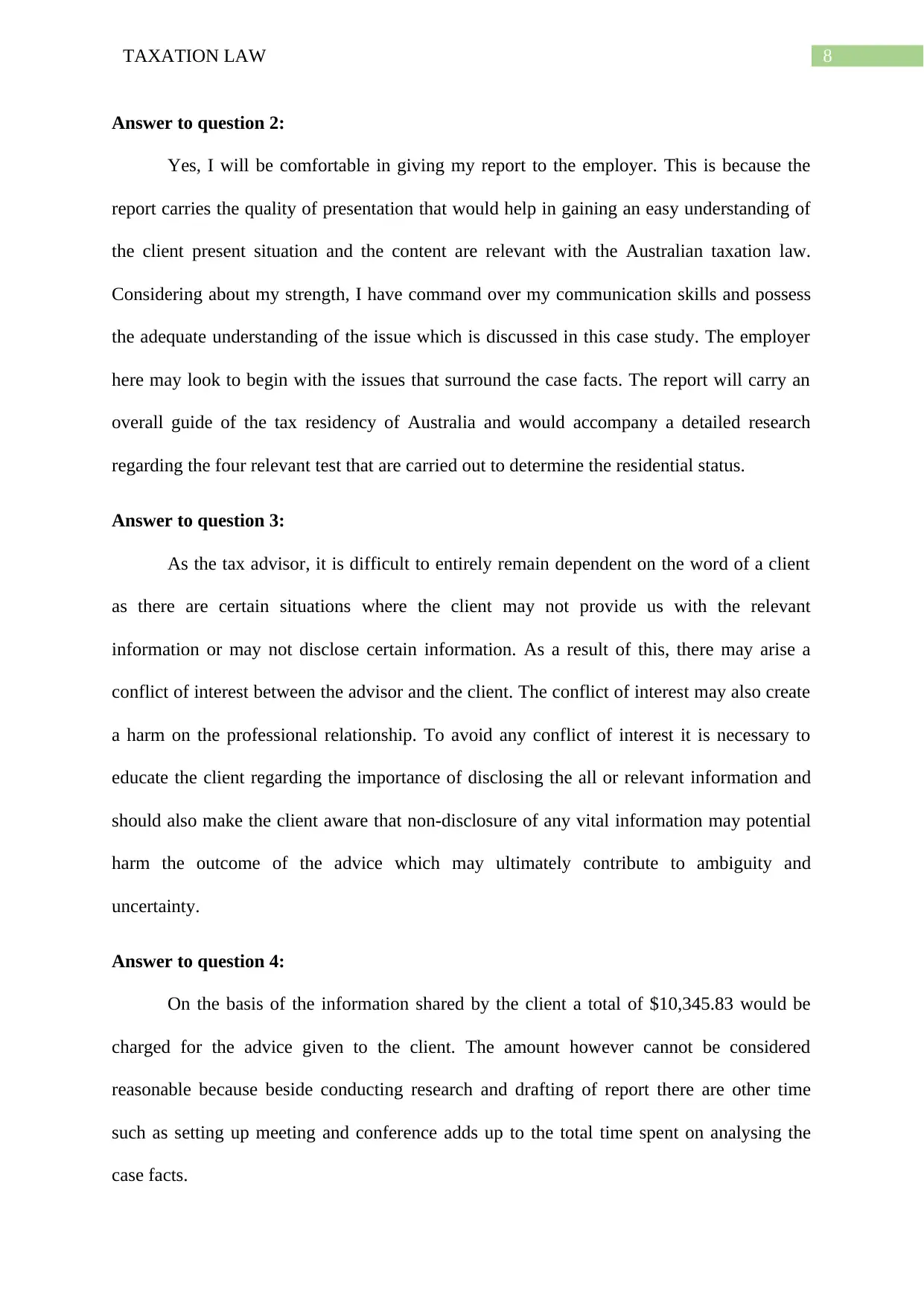
8TAXATION LAW
Answer to question 2:
Yes, I will be comfortable in giving my report to the employer. This is because the
report carries the quality of presentation that would help in gaining an easy understanding of
the client present situation and the content are relevant with the Australian taxation law.
Considering about my strength, I have command over my communication skills and possess
the adequate understanding of the issue which is discussed in this case study. The employer
here may look to begin with the issues that surround the case facts. The report will carry an
overall guide of the tax residency of Australia and would accompany a detailed research
regarding the four relevant test that are carried out to determine the residential status.
Answer to question 3:
As the tax advisor, it is difficult to entirely remain dependent on the word of a client
as there are certain situations where the client may not provide us with the relevant
information or may not disclose certain information. As a result of this, there may arise a
conflict of interest between the advisor and the client. The conflict of interest may also create
a harm on the professional relationship. To avoid any conflict of interest it is necessary to
educate the client regarding the importance of disclosing the all or relevant information and
should also make the client aware that non-disclosure of any vital information may potential
harm the outcome of the advice which may ultimately contribute to ambiguity and
uncertainty.
Answer to question 4:
On the basis of the information shared by the client a total of $10,345.83 would be
charged for the advice given to the client. The amount however cannot be considered
reasonable because beside conducting research and drafting of report there are other time
such as setting up meeting and conference adds up to the total time spent on analysing the
case facts.
Answer to question 2:
Yes, I will be comfortable in giving my report to the employer. This is because the
report carries the quality of presentation that would help in gaining an easy understanding of
the client present situation and the content are relevant with the Australian taxation law.
Considering about my strength, I have command over my communication skills and possess
the adequate understanding of the issue which is discussed in this case study. The employer
here may look to begin with the issues that surround the case facts. The report will carry an
overall guide of the tax residency of Australia and would accompany a detailed research
regarding the four relevant test that are carried out to determine the residential status.
Answer to question 3:
As the tax advisor, it is difficult to entirely remain dependent on the word of a client
as there are certain situations where the client may not provide us with the relevant
information or may not disclose certain information. As a result of this, there may arise a
conflict of interest between the advisor and the client. The conflict of interest may also create
a harm on the professional relationship. To avoid any conflict of interest it is necessary to
educate the client regarding the importance of disclosing the all or relevant information and
should also make the client aware that non-disclosure of any vital information may potential
harm the outcome of the advice which may ultimately contribute to ambiguity and
uncertainty.
Answer to question 4:
On the basis of the information shared by the client a total of $10,345.83 would be
charged for the advice given to the client. The amount however cannot be considered
reasonable because beside conducting research and drafting of report there are other time
such as setting up meeting and conference adds up to the total time spent on analysing the
case facts.
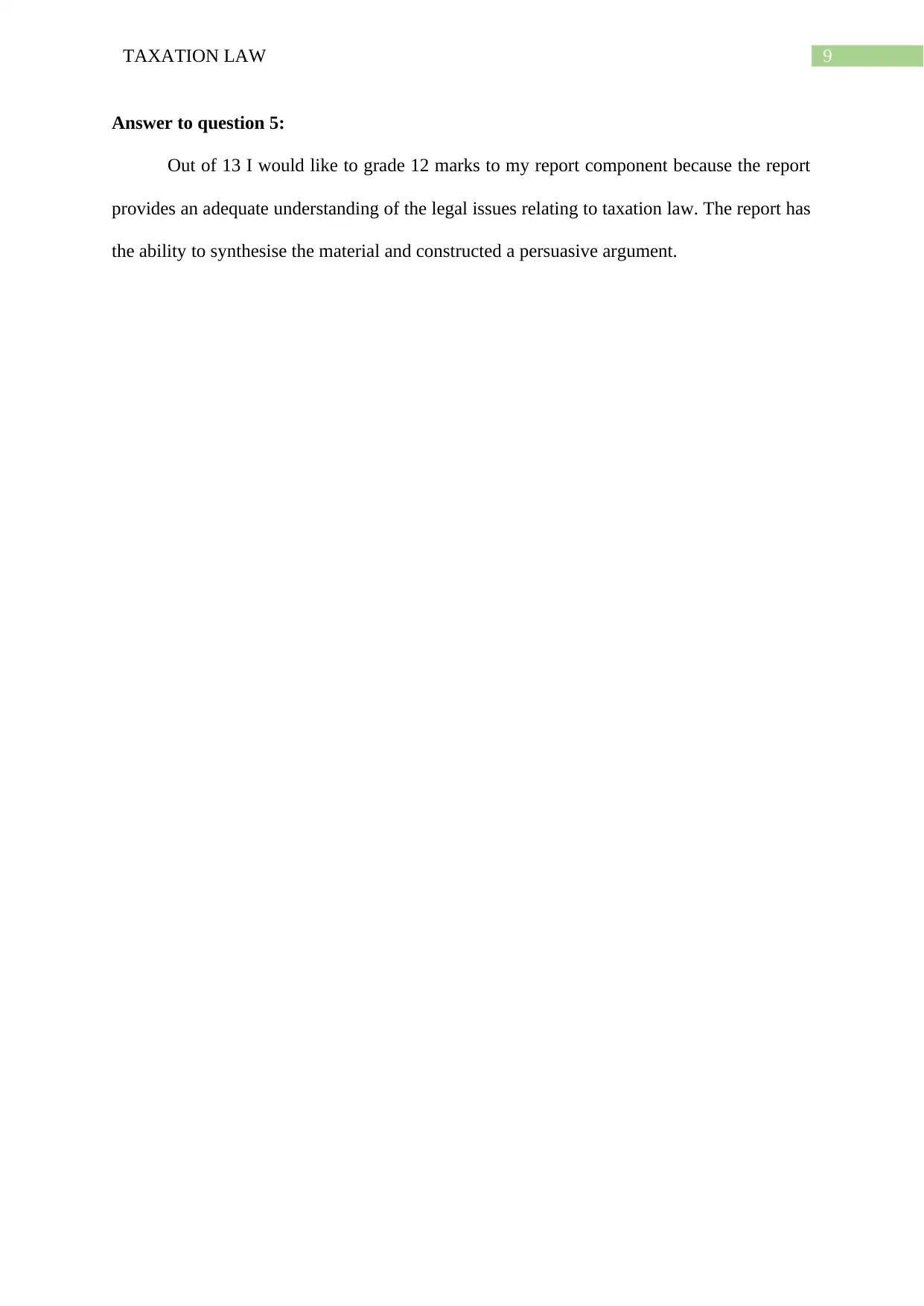
9TAXATION LAW
Answer to question 5:
Out of 13 I would like to grade 12 marks to my report component because the report
provides an adequate understanding of the legal issues relating to taxation law. The report has
the ability to synthesise the material and constructed a persuasive argument.
Answer to question 5:
Out of 13 I would like to grade 12 marks to my report component because the report
provides an adequate understanding of the legal issues relating to taxation law. The report has
the ability to synthesise the material and constructed a persuasive argument.
Secure Best Marks with AI Grader
Need help grading? Try our AI Grader for instant feedback on your assignments.
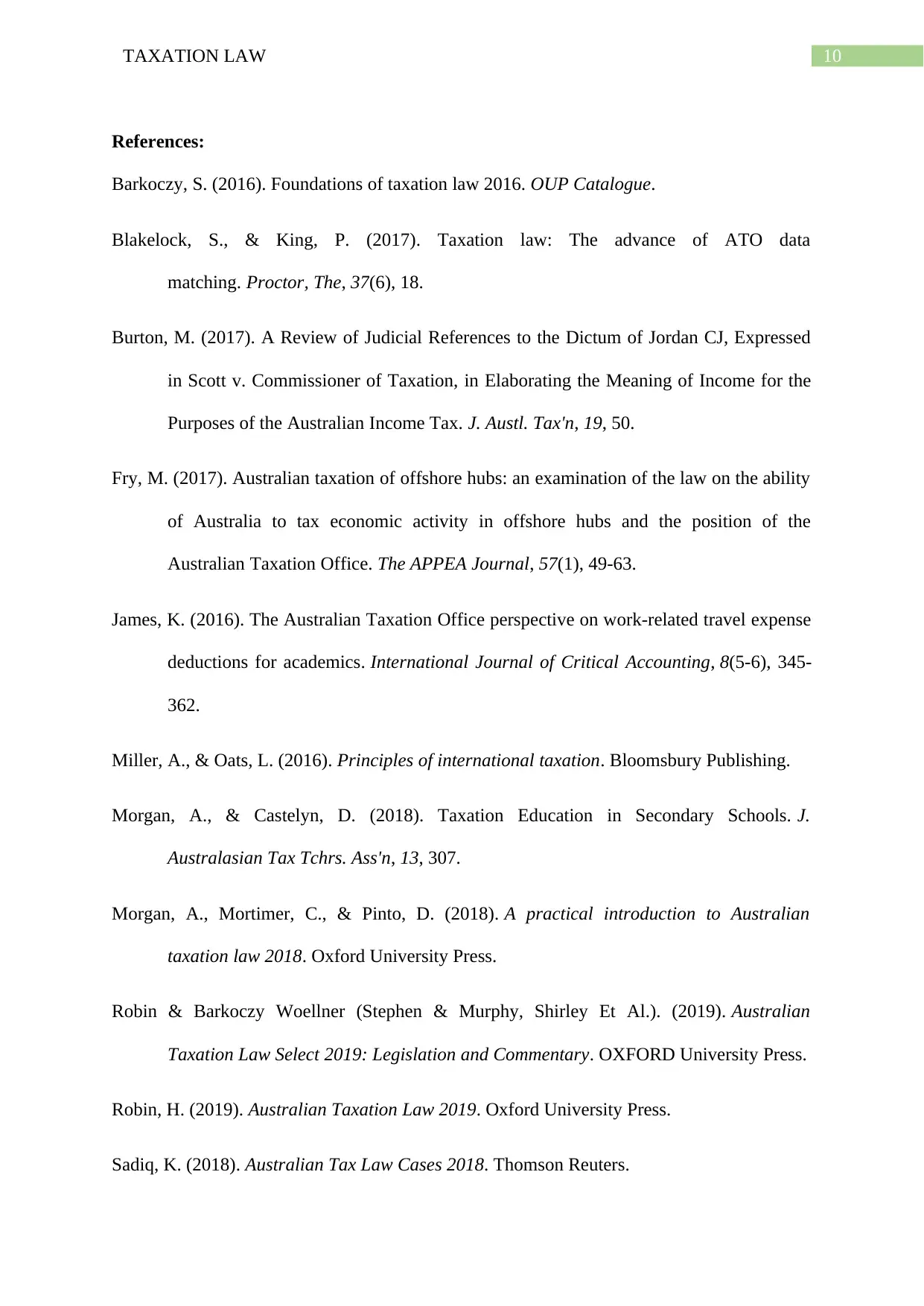
10TAXATION LAW
References:
Barkoczy, S. (2016). Foundations of taxation law 2016. OUP Catalogue.
Blakelock, S., & King, P. (2017). Taxation law: The advance of ATO data
matching. Proctor, The, 37(6), 18.
Burton, M. (2017). A Review of Judicial References to the Dictum of Jordan CJ, Expressed
in Scott v. Commissioner of Taxation, in Elaborating the Meaning of Income for the
Purposes of the Australian Income Tax. J. Austl. Tax'n, 19, 50.
Fry, M. (2017). Australian taxation of offshore hubs: an examination of the law on the ability
of Australia to tax economic activity in offshore hubs and the position of the
Australian Taxation Office. The APPEA Journal, 57(1), 49-63.
James, K. (2016). The Australian Taxation Office perspective on work-related travel expense
deductions for academics. International Journal of Critical Accounting, 8(5-6), 345-
362.
Miller, A., & Oats, L. (2016). Principles of international taxation. Bloomsbury Publishing.
Morgan, A., & Castelyn, D. (2018). Taxation Education in Secondary Schools. J.
Australasian Tax Tchrs. Ass'n, 13, 307.
Morgan, A., Mortimer, C., & Pinto, D. (2018). A practical introduction to Australian
taxation law 2018. Oxford University Press.
Robin & Barkoczy Woellner (Stephen & Murphy, Shirley Et Al.). (2019). Australian
Taxation Law Select 2019: Legislation and Commentary. OXFORD University Press.
Robin, H. (2019). Australian Taxation Law 2019. Oxford University Press.
Sadiq, K. (2018). Australian Tax Law Cases 2018. Thomson Reuters.
References:
Barkoczy, S. (2016). Foundations of taxation law 2016. OUP Catalogue.
Blakelock, S., & King, P. (2017). Taxation law: The advance of ATO data
matching. Proctor, The, 37(6), 18.
Burton, M. (2017). A Review of Judicial References to the Dictum of Jordan CJ, Expressed
in Scott v. Commissioner of Taxation, in Elaborating the Meaning of Income for the
Purposes of the Australian Income Tax. J. Austl. Tax'n, 19, 50.
Fry, M. (2017). Australian taxation of offshore hubs: an examination of the law on the ability
of Australia to tax economic activity in offshore hubs and the position of the
Australian Taxation Office. The APPEA Journal, 57(1), 49-63.
James, K. (2016). The Australian Taxation Office perspective on work-related travel expense
deductions for academics. International Journal of Critical Accounting, 8(5-6), 345-
362.
Miller, A., & Oats, L. (2016). Principles of international taxation. Bloomsbury Publishing.
Morgan, A., & Castelyn, D. (2018). Taxation Education in Secondary Schools. J.
Australasian Tax Tchrs. Ass'n, 13, 307.
Morgan, A., Mortimer, C., & Pinto, D. (2018). A practical introduction to Australian
taxation law 2018. Oxford University Press.
Robin & Barkoczy Woellner (Stephen & Murphy, Shirley Et Al.). (2019). Australian
Taxation Law Select 2019: Legislation and Commentary. OXFORD University Press.
Robin, H. (2019). Australian Taxation Law 2019. Oxford University Press.
Sadiq, K. (2018). Australian Tax Law Cases 2018. Thomson Reuters.
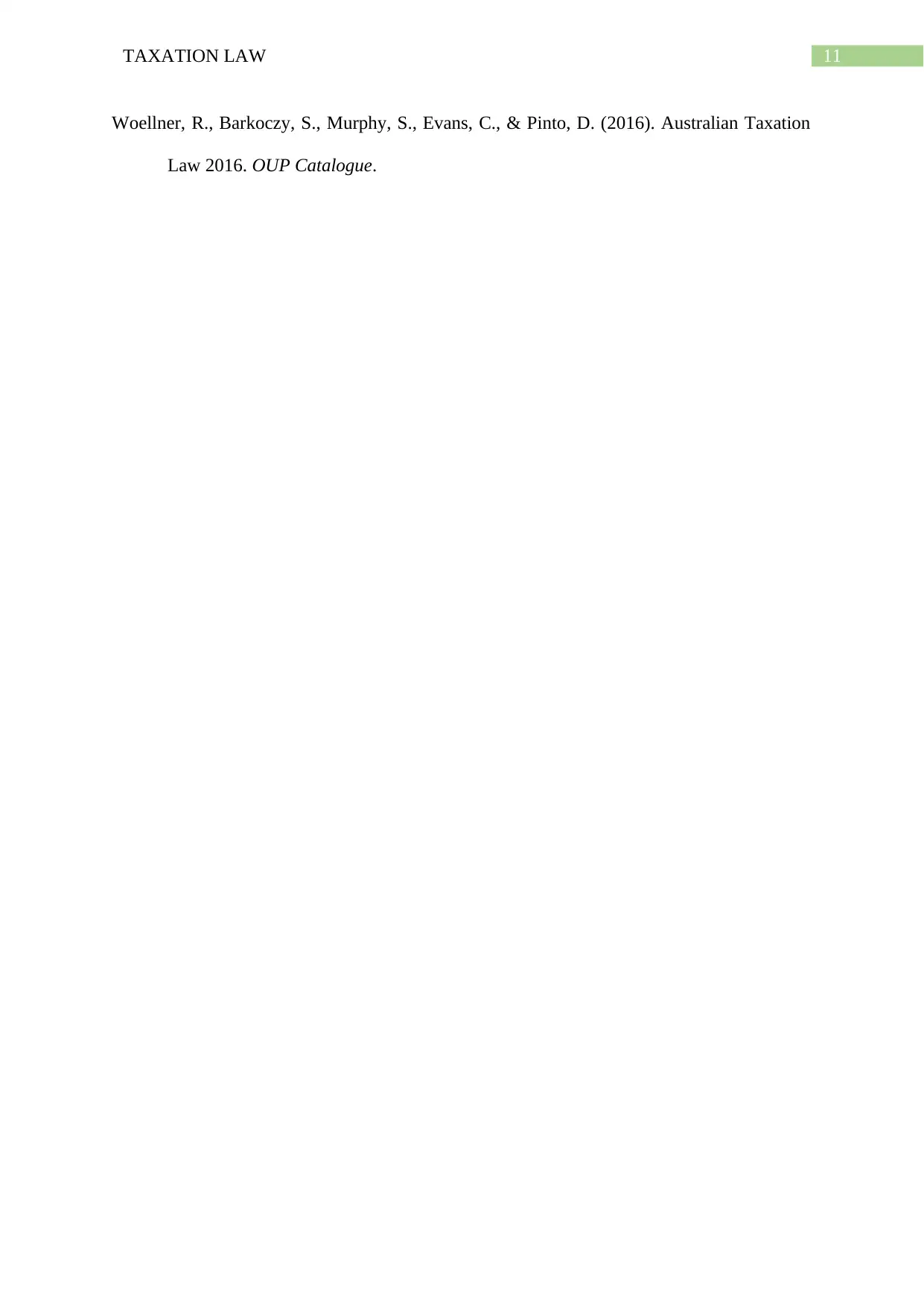
11TAXATION LAW
Woellner, R., Barkoczy, S., Murphy, S., Evans, C., & Pinto, D. (2016). Australian Taxation
Law 2016. OUP Catalogue.
Woellner, R., Barkoczy, S., Murphy, S., Evans, C., & Pinto, D. (2016). Australian Taxation
Law 2016. OUP Catalogue.
1 out of 12
Related Documents
Your All-in-One AI-Powered Toolkit for Academic Success.
+13062052269
info@desklib.com
Available 24*7 on WhatsApp / Email
![[object Object]](/_next/static/media/star-bottom.7253800d.svg)
Unlock your academic potential
© 2024 | Zucol Services PVT LTD | All rights reserved.





